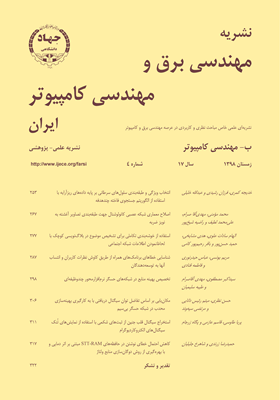تخصیص بهینه منابع در شبکههای حسگر نرمافزارمحور چندوظیفهای
محورهای موضوعی : مهندسی برق و کامپیوترسید اکبر مصطفوی 1 * , مهدی آقاصرام 2 , طیبه سلیمیان 3
1 - دانشگاه یزد
2 - دانشگاه یزد
3 - دانشگاه یزد
کلید واژه: شبکههای حسگر بیسیمشبکههای حسگر نرمافزارمحورتخصیص منابعبهینه سازی,
چکیده مقاله :
در شبکههای حسگر نرمافزارمحور برخلاف شبکههای حسگر بیسیم سنتی که تنها برای یک کاربرد خاص برنامهریزی شدند، میتوان روی هر گره شبکه چندین حسگر تعبیه نمود و برای آن چندین وظیفه به طور همزمان تعریف کرد. هر کدام از این گرههای حسگر دارای یک برنامه مجازیسازی هستند که به آنها امکان میدهد به صورت یک زیرساخت ارتباطی مشترک به چندین کاربرد مختلف، سرویس ارائه کنند. کاربردهای مختلف حسگری در شبکه میتوانند توابع هدف و پارامترهای تصمیمگیری متفاوتی داشته باشند. با توجه به محدودیت منابع گرههای شبکه حسگر، تعدد و تنوع وظایف در هر کاربرد، نیازهای کیفیت سرویس متفاوت هر کاربرد و تفاوت توابع هدف برای کاربردهای مختلف، مسئله تخصیص منابع به وظایف میتواند بسیار پیچیده باشد. در این مقاله، مسئله تخصیص منابع به کاربردهای مختلف گرههای حسگر در شبکههای حسگر نرمافزارمحور با هدف تحقق توابع هدف مختلف به صورت یک مسئله بهینهسازی چندهدفه فرمولبندی میگردد و پاسخ بهینه آن ارائه میشود. با در نظر گرفتن محدودیتهای حافظه و انتخاب کوتاهترین مسیر، روش پیشنهادی میتواند پاسخهای بهتری را در قیاس با روشهای موجود بیابد.
Unlike conventional wireless sensor networks which are designed for a specific application, Software-Defined Wireless Sensor Networks (SDSN) can embed multiple sensors on each node, defining multiple tasks simultaneously. Each sensor node has a virtualization program which serves as a common communication infrastructure for several different applications. Different sensor applications in the network can have different target functions and decision parameters. Due to the resource constraints of sensor network nodes, the multiplicity and variety of tasks in each application, requirements for different levels of quality of service, and the different target functions for different applications, the problem of allocating resources to the tasks on the sensors is complicated. In this paper, we formulate the problem of allocating resources to the sensors in the SDSN with different objective functions as a multi-objective optimization problem and provide an effective solution to solve it.
[1] C. M. D. Farias, et al., "A systematic review of shared sensor networks," ACM Computing Surveys, vol. 44, no. 4, Article No.: 51, Feb. 2016.
[2] C. Delgado, et al., "An optimization framework for resource allocation in virtual sensor networks," in Proc. IEEE Global Communications Conf,. GLOBECOM'15, 7 pp., San Diego, CA, USA, 6-10 Dec. 2015.
[3] N. M. K. Chowdhury and R. Boutaba, "A survey of network virtualization," Computer Networks, vol. 54, no. 5, pp. 862-876, Apr. 2010.
[4] A. Wang, M. Iyer, R. Dutta, G. N. Rouskas, and L. Baldinel, "Network virtualization: technologies, perspectives, and frontiers," Lightwave Technology, vol. 31, no. 4, pp. 523-537, 15 Feb. 2013.
[5] H. Kim and N. Feamster, "Improving network management with software defined networking," IEEE Communications Magazine, vol. 51, no. 2, pp. 114-119, Feb. 2013.
[6] S. Costanzo, L. Galluccio, G. Morabito, and S. Palazzo, "Software defined wireless networks: unbridling SDNs," in Proc. European Workshop on Software Defined Networking, EWSDN'12, 6 pp., Darmstadt, Germany, 25-26 Oct. 2012.
[7] A. P. Jayasumana, Q. Han, and T. H. Illangasekare, "Virtual sensor networks-a resource efficient approach for concurrent application," in Proc. 4th Int. Conf. on IEEE Information Technology, ITNG'07, pp. 111-115, Las Vegas, NV, USA, 2-4 Apr. 2007.
[8] D. Kreutz, et al., "Software-defined networking: a comprehensive survey," Proceeding of the IEEE, vol. 103, no. 1, pp. 14-76, Jan. 2015.
[9] D. Zeng, P. Li, S. Guo, T. Miyazaki, J. Hu, and Y. Xiang, "Energy minimization in multi-task software-defined sensor networks," IEEE Trans. on Computers, vol. 64, no. 11, pp. 3128-3139, Nov. 2015.
[10] S. Bousnina, et al., "A greedy approach for resource allocation in virtual sensor networks," 2017 Wireless Days, pp. 15-20, Porto, Portugal, 29-31 Mar. 2017.
[11] C. Delgado, et al., "Energy-aware dynamic resource allocation in virtual sensor networks," in Proc. 14th IEEE Annual Consumer Communications Networking Conf., CCNC'17, pp. 264-267, Las Vegas, NV, USA, 8-11 Jan. 2017.
[12] S. Tomovic and I. Radusinovic, "Allocation algorithm for handling multiple applications in software-defined WSN," in Proc. 24th Telecommunications Forum, TELFOR'16, 4 pp., Belgrade, Serbia, Nov. 2016.
[13] S. Tomovic and I. Radusinovic, "Mapping application requirements to virtualization-enabled software defined WSN," Wireless Personal Communications, vol. 79, pp. 1693-1709, Feb. 2017.
[14] A. Wang, M. Iyer, R. Dutta, G. N. Rouskas, and I. Baldine, "Network virtualization: technologies, perspectives, and frontiers," Journal of Lightwave Technology, vol. 31, no. 4, pp. 523-537, 15 Feb. 2013.
[15] R. Huang, X. Chu, J. Zhang, and Y. H. Hu, "Energy-efficient monitoring in software defined wireless sensor networks using reinforcement learning: a prototype," International J. of Distributed Sensor Networks, vol. 11, no. 10, pp. 1-12, Aug. 2015.
[16] C. M. de Farias, W. Li, F. C. Delicato, L. Pirmez, P. F. Pires, and A. Y. Zomaya, "SERAPH: service allocation algorithm for the execution of multiple applications in heterogeneous shared sensor and actuator networks," Management of Cyber Physical Objects in the Future Internet of Things, Springer, Cham, vol. 1, pp. 93-113, Jan. 2016.
[17] A. E. Redondi, Energy-Aware Visual Analysis for Wireless Multimedia Sensor Networks, PhD. Dissertation, Politecnico Di Milano, 2014.

